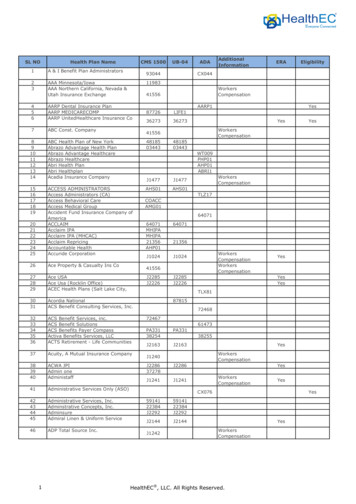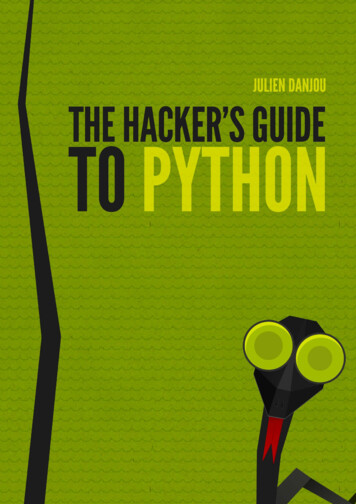
Transcription
Bitter to Better — How to Make Bitcoin a Better CurrencySimon Barber 1 , Xavier Boyen 1 , Elaine Shi 2? , and Ersin Uzun 112Palo Alto Research CenterUniversity of California, BerkeleyAbstract. Bitcoin is a distributed digital currency which has attracted a substantial number of users. We perform an in-depth investigation to understand whatmade Bitcoin so successful, while decades of research on cryptographic e-cashhas not lead to a large-scale deployment. We ask also how Bitcoin could becomea good candidate for a long-lived stable currency. In doing so, we identify severalissues and attacks of Bitcoin, and propose suitable techniques to address them.1IntroductionBitcoin is a decentralized electronic cash system initially designed and developed bySatoshi Nakamoto (whose name is conjectured to be fake by some, and who has notbeen heard from since April 2011). The design of Bitcoin was first described in a selfpublished paper by Nakamoto [14] in October 2008, after which an open-source projectwas registered on sourceforge. The genesis block was established on January 3rd 2009,and the project was announced on the Cryptography mailing list on January 11th 2009.Since its invention, Bitcoin has gained amazing popularity and much attention fromthe press. At the time of the writing, approximately 7M Bitcoins are in circulation;approximately USD 2M to 5M worth of transactions take place each day in Bitcoin;and about eighteen Bitcoin exchanges exist offering exchange services with many realworld currencies, (e.g., EUR, USD, CAD, GBP, PLN, JPY, HKD, SEK, AUD, CHF,and so on). Bitcoin’s exchange rate has varied widely, reaching as high as USD 30 perBitcoin although at the time of writing is around USD 5 per Bitcoin.Despite some pessimists’ critiques and disbelief, Bitcoin has admittedly witnessedenormous success since its invention. To the security and cryptographic community,the idea of digital currency or electronic cash is by no means new. As early as 1982,Chaum has outlined his blueprint of an anonymous e-cash scheme in his pioneering paper [10]. Ever since then, hundreds of academic papers have been published to improvethe efficiency and security of e-cash constructions — to name a few, see [15, 8, 9].Naturally, an interesting question arises: Despite three decades’ research on e-cash,why have e-cash schemes not taken off, while Bitcoin — a system designed and initiallyimplemented possibly single-handedly by someone previously unknown, a system thatuses no fancy cryptography, and is by no means perfect — has enjoyed a swift rise tosuccess? Looking forward, one also wonders: Does Bitcoin have what it takes to becomea serious candidate for a long-lived stable currency, or is it yet another transient fad?Intrigued by these questions, we investigated Bitcoin’s design and history, and cameto many interesting realizations. We therefore present this paper to the (financial) cryptography research community, with the following goals and expectations:?Work done while author was affiliated with PARC.
1. To investigate the Bitcoin phenomenon, and achieve a deeper understanding of thecrucial factors underlying its success, especially compared to other e-cash schemes.2. To scrutinize the design of Bitcoin and analyze its strengths and weakness, in orderto expose and anticipate potential attacks, and focus investigation on key issues;3. To suggest redesigns, improvements, or extensions, such as, e.g., our fail-safe mixerprotocol that requires no third-party and no system modification (Section 7).4. To pose open research problems stemming from our broad reflections on Bitcoin;5. Last but not least, to bring Bitcoin to the attention of the cryptography researchcommunity, to encourage it to reflect on its success, and draw lessons therein.2The Intriguing Success of Bitcoin: A Comparative StudyAs mentioned earlier, despite three decades’ research on e-cash by the cryptographiccommunity [10, 15, 8, 9], all these efforts seem to have been dwindled by the swift success of Bitcoin. Has Nakamoto, a single individual whose name previously unheard of,outsmarted the ingenuity of all the cryptographers combined? Bitcoin is by no meansperfect and some well-known problems are discussed later on. So what is it in Bitcointhat has ensured its success?After an in-depth investigation of Bitcoin, we found that although Bitcoin uses nofancy cryptography, its design actually reflects a suprising amount of ingenuity and sophistication. Most importantly, it addresses the incentive problems most expeditiously.No central point of trust. Bitcoin has a completely distributed architecture, withoutany single trusted entity. Bitcoin assumes that the majority of nodes in its network arehonest, and resorts to a majority vote mechanism for double spending avoidance, anddispute resolution. In contrast, most e-cash schemes require a centralized bank who istrusted for purposes of e-cash issuance, and double-spending detection. This greatly appeals to individuals who wish for a freely-traded currency not in control by any governments, banks, or authorities — from libertarians to drug-dealers and other undergroundeconomy proponents (note that apart from the aforementioned illegal usages, there arenumerous legitimate uses as well, which will be mentioned later). In a spirit similarto the original motivation for a distributed Internet, such a purely decentralized systemguarantees that no single entity, no matter how initially benevolent, can succumb to thetemptation or be coerced by a government into subverting it for its own benefit.Incentives and economic system. Bitcoin’s eco-system is ingeniously designed, andensures that users have economic incentives to participate. First, the generation of newbitcoins happens in a distributed fashion at a predictable rate: “bitcoin miners” solvecomputational puzzles to generate new bitcoins, and this process is closely coupled withthe verification of previous transactions. At the same time, miners also get to collectoptional transaction fees for their effort of vetting said transactions. This gives usersclear economic incentives to invest spare computing cycles in the verification of Bitcointransactions and the generation of new Bitcoins. At the time of writing the investmentof a GPU to accelerate Bitcoin puzzle solution can pay for itself in 6 months.Predictable money supply. Bitcoin makes sure that new coins will be minted at a fixedrate, that is, the larger the Bitcoin community and the total computational resourcedevoted to coin generation, the more difficult the computational puzzle becomes. This
provides strong incentives for early adopters — the earlier in the game, the cheaperthe coins minted. (In a later section we discuss negative consequences that the adoptedmoney supply schedule will have, in the long term, on value, incentives, and security.)Divisibility and fungibility. One practical appeal of Bitcoin is the ease with whichcoins can be both divided and recombined to create essentially any denomination possible. This is an Achilles’ heel of (strongly anonymous) e-cash systems, because denominations had to be standardized to be unlinkable, which incidentally makes the computational cost of e-cash transactions linear in the amount. In Bitcoin, linkage is inherent,as it is what prevents double spending; but it is the identities that are “anonymous”.Versatility, openness, and vibrancy. Bitcoin is remarkably flexible partly due to itscompletely distributed design. The open-source nature of the project entices the creation of new applications and spurs new businesses. Because of its flexibility and openness, a rich extended ecosystem surrounding Bitcoin is flourishing. For example, mixerservices have spawned to cater to users who need better anonymity guarantees (see Section 7 for details). There are payment processor services that offer gadgets venders canembed in their webpages to receive Bitcoin payments alongside regular currency.Scripting. Another salient and very innovative feature is allowing users (payers andpayees) to embed scripts in their Bitcoin transactions. Although today’s reference implementations have not fully utilized the power of this feature, in theory, one can realizerich transactional semantics and contracts through scripts [2], such as deposits, escrowand dispute mediation, assurance contracts, including the use of external states, and soon. It is conceivable that in the future, richer forms of financial contracts and mechanisms are going to be built around Bitcoin using this feature.Transaction irreversibility. Bitcoin transactions quickly become irreversible. This attracts a niche market where vendors are concerned about credit-card fraud and chargebacks. Through personal communication with a vendor selling specialty magazines, hementioned that before, he could not conduct business with customers in certain countries where credit-card fraud prevails. With Bitcoin, he is able to extend his business tothese countries due to the protection he obtains from the irreversibility of transactions.Low fees and friction. The Bitcoin verifiers’ market currently bears very low transaction fees (which are optional and chosen by the payer); this can be attractive in micropayments where fees can dominate. Bitcoin is also appealing for its lack of additionalcosts traditionally tacked upon international money transfers, due to disintermediation.Readily available implementations. Last but not the least, in comparison with other ecash schemes, Bitcoin has provided readily available implementations, not only for thedesktop computer, but also for mobile phones. The open-source project is maintainedby a vibrant community, and has had healthy developments.3Under the Hood of the Bitcoin SystemBitcoin is based on a peer-to-peer network layer that broadcasts data to all nodes onthe network. There are two types of object that are broadcast: transactions and blocks.Both object types are addressed by a hash of the object data, and are broadcast throughthe network to all nodes. Transactions are the operations whereby money is combined,divided, and remitted. Blocks record the transactions vetted as valid.
Spending. Suppose that Alice wishes to remit 1 bitcoin to Bob and 2 to Carol. Alice’scoins “reside” in prior transactions that designate her public key as beneficiary. To spendcoins, Alice creates a new transaction that endorses any such coins she has not spentyet, e.g., she can endorse, using a digital signature, 4 coins each received from Dianeand Edgar as the inputs of her new transaction. As outputs she specifies 1 coin for Bob,2 for Carol, and 4.99 of “change” back to herself. In this example, Alice chose to leavea residual of 0.01 coin, which can be claimed as a fee by whoever vets it first.Vetting. In order for a transaction to be confirmed, its various components must bevalidated and checked against double spending. Once verified, transactions are incorporated in frequently issued official records called blocks. Anyone is allowed to createsuch blocks, and indeed two sorts of incentives are offered to attract verifiers to competefor block creation: (1) the collection of fees; and (2) the minting of new coins.Minting. The bitcoin money supply expands as each block created may contain a special generation transaction (with no explicit input) that pays the block creator a timedependent amount for the effort (50 coins today, rapidly decreasing). The rate of block,hence money, creation is limited by a proof of work of adaptive difficulty, that strives tomaintain a creation rate of one block every 10 minutes across the whole network. Bitcoin transaction verification is thus a lucrative race open to all, but a computationallyexpensive one. Note: “bad” blocks will be rejected by peers, invalidating their rewards.3.1Transactions and Scripting: the Tools for SpendingOne of the main powers of the Bitcoin system is that the input and output of transactionsneed not have a fixed format, but rather are constructed using a Forth-like stack-basedflexible scripting language. We remark that transaction principals are not named usersbut anonymous public keys, which users may freely create in any number they wish.Transactions. Transaction encapsulate the movement of bitcoins by transfering thevalue received from its inputs to its outputs (exception: generation transactions haveno explicit input at all). An input identifies a previous transaction output (as the hashof the earlier transaction and an index to an output within it), and claims its full value.An output specifies an amount; the outputs’ total must not exceed the inputs’. Both alsocontain fragments of executable script, on the input side for redeeming inflows, and onthe output side for designating payees.Script fragments. The scripting language is a Forth-like stack-based language. Operators include cryptographic operations like SHA1 (which replaces the top item on thestack with its hash), and CHECKSIG (which pops an ECDSA public key and signaturefrom the stack, verifies the signature for a “message” implicitly defined from the transaction data, and leaves the result as a true or false on the stack). For a transaction to bevalid, its outputs must not exceed its inputs, and its issuer must show title to each inputclaimed. Title is tested by evaluating the input script fragment concatenated with thescript fragment from the output (of an earlier transaction) that the input references.Standard transfer. To illustrate how the stack-based scripting language can be used,among other things, to designate and enforce the recipient of a transfer, we study the example of the standard Bitcoin transaction used for transfer. To send coins to an addressstated as the hash of a public key, the payer, Alice, creates a transaction output with
the following associated script fragment (recall that since the amount is specified in aspecial record associated with the output; the script only needs to enforce the recipient):DUP HASH160 recipient-address EQUALVERIFY CHECKSIG(?)The recipient, Bob, will notice the remittance (since it is broadcast to all), and mark itfor spending. Later on, to spend those received coins, he creates a transaction with aninput that redeems them, and an output that spends them. The redeeming input script is: signature public-key (?)Bob will have managed to spend coins received from Alice if his redemption is valid.This is checked by executing the concatenated script (?, ?): the input fragment (?)pushes a signature and a key on the stack; the output fragment (?) checks that the keyhash matches the recipient, and checks the signature against transaction and key.3.2 Blocks and Coin Creation: the Process of VerifyingTransactions become effective after they have been referenced in a block, which serve asthe official record of executed transactions. Transactions may only be listed in a blockif they satisfy such conditions as valid timestamping and absence of double spending.Blocks. A block consists of one “coinbase” minting transaction, zero or more regularspending transactions, a computational proof of work, and a reference to the chronologically prior block. Thus the blocks form a singly linked blockchain, rooted in Nakamoto’sgenesis block whose hash is hardcoded in the software. The regular creation of newblocks serves the dual purpose of ensuring the timely vetting of new transactions, andthe creation of new coins, all in a decentralized process driven by economic incentives(the minting of new coins and the collection of fees) balanced by computational costs.The difficulty of the required proof of work is adjusted by a feedback mechanism thatensures an average block creation interval of 10 minutes across the entire network.Coinbase. Currently, each new block may contain a coinbase transaction with an implicit input value of 50 coins, with about 7M already minted as of this writing. Theminting rate is slated to decrease shortly, eventually to reach zero when the total supplyreaches about 21M bitcoins. The coinbase transaction also serves to claim all the fees inthe transactions collected in the block. Both minting and fees motivate people to createblocks and hence keep the system alive.3.3 Forking and Conflict ResolutionIf two blocks are published nearly simultaneously, a fork in the chain can occur. Nodesare programmed to follow the blockchain whose total proof-of-work difficulty is thelargest and discard blocks from other forks. Transactions on the discarded branch willeventually be collected into blocks on the prevailing branch. This mechanism ensuresthat one single ordering of transactions becomes apparent and accepted by all (althoughit may take a few blocks’ time to become clear), and hence this solves the doublespending problem.4Structural Problems and Potential SolutionsWhether by accident or by design, the Bitcoin system as presently parameterized definesa currency with extreme deflationary characteristics built into it. Currently coins are
minted by verifiers (i.e., block creators, or “miners”) as an incentive to keep the Bitcoinecosystem running, but minting is poised to expire gradually, and rather soon, resultingin a hard cap on the coins total. Moreover, coins whose private key has been forgotten ordestroyed — let us call them zombie coins — can never be replaced, resulting in furthershrinkage of the money base. For perspective, of the 21M coins maximum, 7M havealready been minted; and of those, tens of thousands have reportedly become zombies.Aside from economic considerations that have been discussed at length [4], Thepotential deflationary spiral in a decentralized system like Bitcoin has security implications that should not be neglected.4.1Deflationary SpiralIn capped supply, bitcoins have no alternative but to appreciate tremendously should thesystem ever gain more than marginal acceptance. Even in a “mature market” scenariowith, say, a stable 1% of the US GDP transacted in BitCoins and 99% in dollars, the realpurchasing power of coins would still increase over time, as each coin would capturea correspondingly constant fraction of the country’s growing wealth. Put in anotherway, while the Federal Reserve can increase the number of dollars in circulation toaccommodate economic growth, in a Bitcoin economy the only outlet for growth wouldbe appreciation of the currency. While it has been observed that the money supply capcould lead to a severe deflationary spiral [4], it is quite a paradox that the intrinsicstrength of the Bitcoin currency could be its greatest weakness, causing an even morecatastrophic unraveling than through “mere” deflation.Hoarding: a moral hazard? Bitcoins much more than any other currency in existencederive their value from the presence of a live, dynamic infrastructure loosely constitutedby the network of verifiers participating in block creation. Because of their appreciationpotential, bitcoins will tend to be saved rather than spent. As hoarded bitcoins vanishfrom circulation, transaction volume will dwindle and block creation will become lessprofitable (fewer fees to collect). If circulation drops too much, it can precipitate a lossof interest in the system, resulting in “bit rot” and verifier dearth, until such point thatthe system has become too weak to heal and defend itself. Of particular concern is anunavoidable large-scale fraud that we describe in the next section, and whose aftermathincludes sudden loss of confidence, collapse of value, and repudiation.Towards decentralized organic inflation. An antidote to the preceding predicamentcould take the form of a Bitcoin-like electronic currency with a decentralized inflationary feedback built-in, that could control the global minting rate based, e.g., on transaction volume statistics. While we leave the devising of monetary parameters for such an“organically inflationary” currency as an open problem, we show next how deflationaryexpectations negatively impact the long-term structural security of the Bitcoin system.4.2Doomsday, or the “History-Revision” AttackIn the Bitcoin world, transactions are irrevocably valid once they are incorporated intothe ever growing Block Chain, insofar as they do not end up in the discarded branchof a fork. As previously described, short-lived forks may arise, but tend to be quicklyresolved per the rule that the chain whose “total difficulty” is the greatest, prevails.
Most forks are benign, causing the few transactions on the wrong side of the fork to bedelayed — merely a temporary rejection, unless double spending was attempted.This approach works well, under the crucial assumption that no attacker should everbe able to muster so much computational power that it is able to fake and publish an“alternative history”, created ex post facto, that has greater total difficulty and henceis more authoritative than the actual history. In such event, the forking rules wouldcause the actual history to be discarded in favor of the alternative history, from theforking point onwards. We designate this as the history-revision attack. In the extremecase where the fork is made near time zero, a history-revision attacker would cause theentire coin base ever created to be replaced with a figment of its forgery.One may take solace in the ludicrous amount of computing power that, one mighthope, such a history-revision attack would require. Alas, the threat is very real — owingboth to technical and monetary characteristics of Bitcoin.Technical vulnerability. The attack’s feasibility stems from Moore’s law, which empirically posits that computation power per unit cost is doubling every year or so. Assuming a stable population of verifiers, the block difficulty parameter (set by the system tomaintain a block creation mean interval of 10 minutes) is thus an exponential functionof time, f (t) α et/τ . The total difficulty of the block chain at any point in time is thusRtapproximated by the integral F (t) t0 f (t0 )dt0 f (t). It follows that, regardless ofthe block chain’s length, an attacker that can muster a small multiple (say 2 ) of thecomputation power of the legitimate verifiers together, and starting an attack at timet t1 , will be able to create an entire alternative history forked at the origin time t0 ,whose total difficulty F 0 (t) overtakes F (t) at some future time t t2 , where the attacklength t t2 t1 is bounded by a constant (about 1–2 years for a 2 multiple). 3Economic motivation. The strong deflationary characteristic of Bitcoin further compounds the problem. On the one hand, Bitcoins are a currency poised to explode invalue, ceteris paribus, as already discussed; and hence so will the incentive for theft.On the other hand, the way deflation comes into play, driven by a hard cap on the moneysupply, will all but eliminate the money-minting incentive that currently draws in themany verifiers that by their competition contribute to make block creation a difficultproblem. With this incentive dwindling, laws of economics dictate that the competitive effort devoted to verifying transactions and creating blocks will diminish. In otherwords, while block difficulty may continue to increase for some time into the future, itwill eventually start to decrease relatively to the power of the day’s typical PC. Historyrevision attacks will thence become easier not harder.4.3 Countering “Revisionism” by Checkpointing the PastWe outline a distributed strategy to tackle the history-revision attack threat in a simple and elegant way. Its principle is rooted in the commonsense notion that one oughtto be suspicious of tales that conflict with one’s own first-hand recollection of events.3To underscore the seriousness of the threat, we note that it is common nowadays for minersto pool their resources and, by some estimates, one such mining pool, deepbit, contributes40% of the total computation power devoted to mining in the entire system. Merely doublingits “market share” would make it able to revise the entire Bitcoin history in a year’s time,owing to Moore’s law. Botnets and governments may be there already.
Translated in the Bitcoin world, we propose that a Verifier that has been running without interruption for a long time, should be “highly skeptical” of any long-range forkresolution that would drastically change its own private view of the transaction historyacquired from first-hand data collection and block creation.Private checkpointing. Verifiers should thus timestamp published transactions as theysee them, and privately take regular snapshots of their own view of the transaction history (such snapshots should be made tamper-proof, e.g., with a cryptographic forwardsecure signature). If in the future a drastic fork is put forth that is inconsistent withmany of the various snapshots taken, the verifier should demand an increasingly highburden of proof before accepting the “new” branch as correct. E.g., the verifier shouldnot merely accept an alternative branch whose total difficulty exceeds that of the privately checkpointed history, but demand an increasingly high margin of excess, thelonger and the more improbable the alternative branch is deemed w.r.t. the verifier’sprivate knowledge.Implicit voting and phase transition. Verifiers ought to make such determination independently, based on their own remembered history. That is to say that “young” verifiersthat recently came online, and acquired their history by downloading the transactionlog ex post facto, would have little first-hand checkpointing to rely upon, and wouldthus behave as in the current system (merely favoring the most difficult branch in afork). “Seasoned” verifiers that have seen and checkpointed ancient transactions firsthand, would on the contrary oppose a resisting force of skepticism against what theyperceive could be an attempt to revise history. As a result, the network would partitioninto two camps, but only briefly, as certain verifiers that are on the fence “flip” one wayor the other based on observing their peers’ endorsement of either branch of the fork.Eventually, as more and more verifiers endorse one position over the other, and the corresponding branch of the fork grows faster, the whole network will “phase-transition”back to a single unified view.Comparative behavior. Our strategy is a strict improvement over the current Bitcoinhandling of history-revision attacks, for in all cases where a history-revision attackwould fail in the current system, our system would behave identically (and exhibitno partition, and no subsequent phase transition). It is only in cases where a historyrevision attack would have succeeded in the current system, that a partition could occurin the new system. A partition could remain meta-stable for a certain time, but eventually ought to resolve itself by taking the bulk of the network to one side or the other.Checkpointing today. We remark that the current protocol already does what we wouldcall “fiat checkpointing”, where authoritative checkpoints (in the form of hardcodedhashes of certain blocks) are pushed out with software updates [12]. Alas, there is noreason to trust a download of the software any more than one of the transaction historyitself. This is unlke our private checkpointing proposal which emphatically prescribesfirst-hand checkpoints, independently made by each verifier in a privately tamper-proofdecentralized way.We leave as an open problem the formal design and analysis of “anti-revisionismprofiles” that offer marked security against vastly powerful history-revision attacks,while guaranteeing that partitions caused by accidental forks get quickly resolved.
5Theft or Loss of BitcoinsAs all bitcoins are public knowledge (in the form of unredeemed transaction outputs),what enables a user to spend a coin is possession of the associated private key. Theft orloss of private keys, or signature forgeries, thus equate to loss of money in this world.5.1 Malware AttacksReported malware attacks on Bitcoin are on the rise [16, 1], resulting in the theft of private keys. The online wallet service mybitcoin.com recently lost 1.3 million worthof users’ coins due to malware [1]. Several solutions can be envisaged; we mention:Threshold cryptography. A natural countermeasure to malware is to split private keysinto random shares, using standard threshold cryptography techniques [11, 13], and distribute them onto multiple locations, e.g., a user’s desktop computer, her smart phone,and an online service provider. In this way, only when a threshold number of these devices collaborate, can a user spend her coins. Of course, doing so can harm the usabilityof the system, since coins can no longer be spent without operating multiple devices(even though not all the devices but only a chosen number of them are needed at once).Super-wallets. To address the usability concern, we propose the simple idea of superwallet, i.e., a user’s “personal bank” where most of her coins are stored. The superwallet is split across multiple computing devices, using threshold techniques as above.In addition, the user carries a small sub-wallet with her on her smartphone. Pre-approvedtransactions are setup so that the user can withdraw money from her super-wallet ontoher sub-wallet, periodically in small amounts (similar to how real banks let people withdraw cash from ATMs today). The user now only needs her smartphone to spend moneyin her wallet, and in case her smartphone is captured by an adversary, the user only losesthe small amount of money that she has in her wallet, but not that in her personal bank.Large amounts can always be spent from the super-wallet using a threshold of devices.Both approaches can be implemented as backward-compatible and incrementallydeployable wrappers, requiring changes in the signature generation but not verification.5.2 Accidental Loss of BitcoinsApart from malware, system failures or human errors can cause the acciden
has not lead to a large-scale deployment. We ask also how Bitcoin could become a good candidate for a long-lived stable currency. In doing so, we identify several issues and attacks of Bitcoin, and propose suitable techniques to address them. 1 Introduction Bitcoin is a decentralized electronic cash system initially designed and developed by










